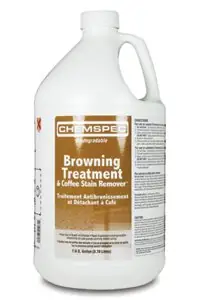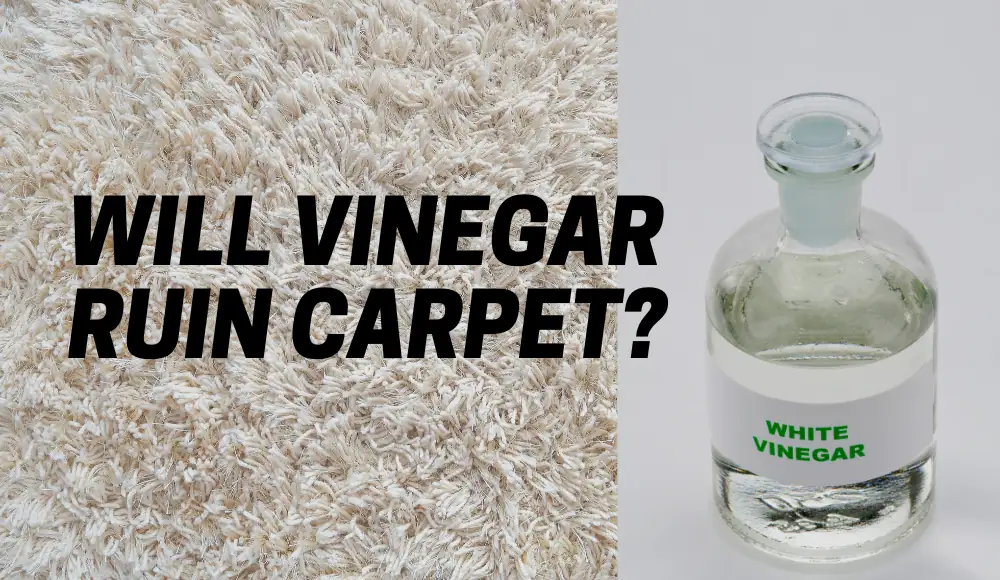Last updated on October 29th, 2023 at 02:40 am
Brown stains on carpet are an unsightly nuisance that can leave you scratching your head, wondering what went wrong during your cleaning efforts. It’s frustrating, isn’t it?
You clean your carpet to make it look fresh and vibrant, but instead, you’re left with mysterious brown spots. In this comprehensive guide, we’ll delve into the reasons behind this carpet conundrum, offer solutions to remove those stubborn stains, and provide tips to prevent them in the future.
Understanding the Mysterious Brown Stains on Carpet
Why did my carpet turn brown after cleaning?
The sudden appearance of brown stains on your carpet can be quite perplexing. The culprit often lies in the residue left behind during the cleaning process. Sometimes, it’s the cleaning solution you used, but other times, it’s a result of trapped moisture and dirt that wicks up to the surface as your carpet dries.
When you clean your carpet, especially if it’s been a while since the last cleaning, you’re removing not only surface dirt but also deeply embedded particles. These particles might have included stains from spills long forgotten.
As you clean, moisture and cleaning solution can dislodge these particles and bring them to the surface, resulting in those unsightly brown stains.
What is this brown stuff on my carpet?
The brown stuff on your carpet is often a mixture of dirt, old stains, and cleaning solution residue. When moisture interacts with these elements, it can lead to the formation of those unsightly brown spots.
To prevent this from happening, it’s crucial to use a high-quality carpet cleaner that effectively removes the dirt and stains without leaving behind a residue. Always ensure thorough rinsing during the cleaning process to minimize the chances of brown stains appearing.

What are the brown spots on carpet under the bed?
Brown spots under the bed are particularly common. Due to limited airflow, moisture tends to get trapped beneath your bed, leading to the accumulation of dust and dirt, which can result in brown stains. These hidden stains can be a real challenge to deal with, but with the right approach, you can restore your carpet to its original beauty.
The first step in addressing these hidden brown spots is to move the bed and allow the carpet to breathe. This will help dry out the trapped moisture and minimize the risk of further stains. Then, follow the steps outlined in this guide to remove the existing brown stains.
How to get rid of brown stains on wool carpet?
Wool carpets require special care. The delicate fibers can easily trap moisture and clean residues, causing brown stains. To protect your wool carpet, it’s crucial to select cleaning products and methods that are wool-safe.
Always check the labels on your cleaning solutions to ensure they are suitable for use on wool. In addition, avoid over-wetting the carpet, as excessive moisture can lead to brown stains. If you’re unsure about cleaning your wool carpet, consider consulting a professional who specializes in wool carpet care.
—
The Carpet Cleaning Dilemma: Why Does My Carpet Look Dirtier After Shampooing?
It’s a scenario we’ve all faced: you diligently shampoo your carpet to eliminate stains and dirt, only to find it looking dirtier than before. This perplexing situation often arises due to incomplete rinsing and residue buildup from the cleaning solution.
When you shampoo your carpet, you’re introducing a mixture of water and cleaning solution deep into the fibers. This mixture loosens dirt and stains, making it easier to remove. However, if not all the cleaning solution and dirt are effectively extracted during the rinsing process, they can remain in the carpet, causing it to look dirtier.
To prevent this, it’s essential to follow the manufacturer’s instructions for your carpet cleaning machine carefully. Ensure that you perform thorough rinsing, and avoid over-saturating the carpet, as excessive moisture can lead to brown stains.
Removing Stubborn Brown Stains on Your Carpet
What stains are permanent on the carpet?
Not all stains are created equal. Some stubborn stains may seem permanent, but with the right techniques, they can be removed. We’ll provide strategies for tackling even the toughest stains.
Permanent stains are typically caused by substances that alter the color of the carpet fibers, such as bleach or certain dyes. While it’s challenging to completely remove these stains, you can often improve their appearance with specialized stain removers. Be cautious when using bleach or other chemicals, as they can damage the carpet fibers or alter their color further.
Why is my wet carpet turning brown?
Moisture plays a significant role in carpet discoloration. We’ll explore how improper drying can lead to brown stains and offer tips on ensuring your carpet dries completely.
When your carpet remains wet for an extended period, it provides an ideal environment for mold and mildew to grow. These microorganisms can produce brown or black stains. To prevent this, ensure your carpet dries thoroughly after cleaning. Use fans and open windows to promote airflow, and if necessary, consider using a dehumidifier to remove excess moisture from the air.
What causes cellulosic browning?
Cellulosic browning, also known as cellulose browning, is a type of carpet discoloration that occurs when cellulose-based materials, such as the natural fibers in carpets, absorb moisture and then react with that moisture, causing a brown or yellowish discoloration. Here are some of the key factors and causes of cellulosic browning:
- Cellulose Content: The primary cause of cellulosic browning is the presence of cellulose in the carpet fibers. Many natural fibers, such as jute, cotton, and some types of wool, contain cellulose. When these fibers absorb moisture, they can undergo a chemical reaction that leads to browning.
- Moisture: Moisture is a critical factor in cellulosic browning. When a carpet with cellulose-based fibers becomes wet, whether through cleaning or exposure to spills or high humidity, the moisture can trigger the browning process.
- pH Levels: The pH of the carpet and the surrounding environment can influence cellulosic browning. Alkaline conditions, with a pH above 7, can accelerate the browning process. Cleaning solutions that are too alkaline can contribute to this problem.
- Microbial Activity: Bacteria and fungi, particularly those that thrive in damp conditions, can contribute to cellulosic browning. These microorganisms produce enzymes that break down cellulose, resulting in a brownish discoloration. This is more common in environments with high humidity or in the presence of organic matter.
- Slow Drying: Inadequate or slow drying of a wet carpet can exacerbate cellulosic browning. When moisture remains in the carpet for an extended period, it provides the ideal conditions for the chemical reaction that causes browning.
- Cleaning Solutions: Some cleaning solutions, especially those with high pH levels or excessive residue, can contribute to browning if not thoroughly rinsed from the carpet.
To prevent cellulosic browning, it’s important to use proper cleaning techniques, ensure thorough rinsing, and promote effective drying. In cases where cellulosic browning has already occurred, it may be necessary to use specialized cleaning methods and stain removers to address the issue.
If the browning persists or is extensive, seeking the assistance of a professional carpet cleaner may be the best course of action.
How do you remove cellulosic browning stains?
Cellulosic browning stains can be a particularly tricky challenge. We’ll discuss effective methods to combat these stains, which are often caused by over-wetting during cleaning.
Cellulosic browning stains occur when excessive moisture interacts with the cellulose in the carpet fibers. To remove these stains, you can start by blotting the affected area with a clean, dry cloth to absorb excess moisture. Then, apply a mixture of white vinegar and water (1:1 ratio) to the stain and blot again. Finally, rinse with clean water and blot dry.
—
What is the anti-browning agent for carpet?
Anti-browning agents are chemical substances used to prevent or counteract browning in carpets, particularly cellulosic browning, which is caused by moisture and the interaction of cellulose fibers with that moisture. These agents work by inhibiting the chemical reactions that lead to discoloration. Here are some common anti-browning agents used in the carpet cleaning industry:
| Anti-Browning Agent | Description |
|---|---|
| Acetic Acid | Acetic acid, commonly known as white vinegar, is sometimes used as an anti-browning agent. When diluted and applied to the carpet, it can help neutralize alkaline residues left behind after cleaning, which can contribute to browning. |
| Citric Acid | Citric acid is another natural acid that can be used to counteract browning. It works by neutralizing alkaline residues and can be applied to the carpet in a diluted form. |
| Oxidizing Agents | Some anti-browning agents are oxidizing agents that work by breaking down the compounds responsible for browning. For example, hydrogen peroxide can be used to bleach and neutralize browning stains. It should be used with caution and in the appropriate dilution. |
| Browning Inhibitors | There are commercial browning inhibitors available in the market. These products are specially formulated to prevent and treat browning in carpets. They often contain a combination of ingredients designed to neutralize alkaline residues and inhibit the chemical reactions that lead to browning. |
| pH Neutralizing Rinse | After cleaning, using a pH-neutralizing rinse can help prevent browning. These rinses are designed to bring the carpet’s pH back to a neutral level, reducing the risk of alkaline residues that can contribute to browning. |
| Professional Carpet Cleaning Solutions | Many professional carpet cleaning solutions include built-in anti-browning agents. These solutions are formulated to minimize residue, maintain the carpet’s pH balance, and prevent browning. |
It’s important to follow the manufacturer’s recommendations and guidelines when using any anti-browning agent on your carpet. Overuse or incorrect application can lead to other issues, and in some cases, they might not be suitable for all types of carpets.
When in doubt or when dealing with extensive browning, it’s a good idea to consult a professional carpet cleaner who can select the most appropriate anti-browning agent and treatment for your specific situation.
Are Brown Stains on My Carpet Harmful or Permanent?
You might be wondering whether those brown stains are more than just an eyesore. We’ll address concerns about the long-term effects of brown stains and whether they can cause damage to your carpet.
Brown stains are often a cosmetic issue and may not necessarily indicate permanent damage. However, leaving stains unattended for extended periods can make them more challenging to remove.
Additionally, if the stains are the result of mold or mildew growth, they can have health implications. It’s essential to address brown stains promptly to prevent potential harm to your carpet and your well-being.
Preventing Brown Stains After Carpet Cleaning
How Can I Prevent Brown Stains After Carpet Cleaning?
Prevention is often the best solution. We’ll provide tips and advice on how to avoid brown stains during the carpet cleaning process, such as proper drying techniques and using the right cleaning products.
To prevent brown stains after carpet cleaning, follow these tips:
- Use a high-quality carpet cleaner that leaves minimal residue.
- Ensure thorough rinsing during the cleaning process to remove all cleaning solution.
- Avoid over-saturating the carpet to prevent excess moisture.
What Cleaning Products Can Cause Brown Stains on Carpets?
Sometimes, it’s the cleaning products themselves that contribute to the problem. We’ll list specific cleaning products or ingredients that may lead to brown stains and suggest alternative products that are safer for your carpets.
Certain cleaning products, especially those with high chemical content or excessive foaming agents, can leave behind residue that causes brown stains. Look for carpet cleaners that are labeled as residue-free or low-foam. Natural and eco-friendly cleaning solutions can also be a safer choice.
Getting Rid of Brown Stains: DIY vs. Professional Help
How to Remove Brown Stains on Carpets After Cleaning?
If you find brown stains on your carpet, don’t fret. We’ll offer step-by-step instructions and methods for effectively removing brown stains, including DIY solutions and professional cleaning options.
DIY Stain Removal:
- Blot the stain: Use a clean, white cloth to blot the stain gently. Avoid rubbing, as it can spread the stain.
- Prepare a cleaning solution: Mix one tablespoon of dishwashing liquid with two cups of warm water.
- Apply the solution: Dip a cloth or sponge into the cleaning solution and blot the stain. Continue until the stain lightens.
- Rinse with clean water: Dampen a clean cloth with water and blot the area to remove the cleaning solution.
- Dry the carpet: Use a fan or open windows to help the carpet dry quickly.
If the stain persists, consider professional help.
Can I Remove Brown Stains from My Carpet Without Professional Help?
While many stains can be tackled as DIY projects, some may require the expertise of a professional cleaner. We’ll help you determine when it’s best to hire a professional.
If the brown stain proves stubborn and resists your DIY efforts, it’s advisable to consult a professional carpet cleaner. They have the tools, experience, and specialized solutions to deal with challenging stains effectively.
—
Is There a Difference Between Old and New Brown Stains?
Addressing the challenges of removing older versus newer brown stains, we’ll provide strategies for both scenarios. Time can be a crucial factor in stain removal.
Older brown stains may be more deeply embedded in the carpet, making them challenging to remove completely. For older stains, it’s essential to be patient and persistent in your cleaning efforts. Newer stains are generally easier to tackle, as they haven’t had time to set and become more stubborn.
The Bigger Picture: Brown Stains as a Sign of Underlying Issues
Can Brown Stains on Carpets Be a Sign of a Larger Problem?
Sometimes, brown stains can hint at underlying issues like mold or mildew. We’ll mention the possibility and advise on when to seek professional inspection, ensuring the health of your home and family.
Brown stains, especially if they return after cleaning, can be indicative of an underlying issue. This issue may be mold or mildew growth, water damage, or even a plumbing problem. If your brown stains persist, it’s advisable to seek a professional inspection to address the root cause of the problem and prevent further damage to your home.
Conclusion
In this comprehensive guide, we’ve covered every aspect of dealing with those pesky brown stains on your carpet. From understanding their origins to efficient removal techniques and long-term prevention, you’ll be equipped with the knowledge needed to restore your carpet to its pristine condition.
Remember, the key to a clean and vibrant carpet is not just in cleaning but also in understanding the science behind it. Your home deserves nothing less!
Don’t hesitate to consult a professional if the stains persist or you suspect underlying issues. Your carpet and your family’s health are worth the investment.




